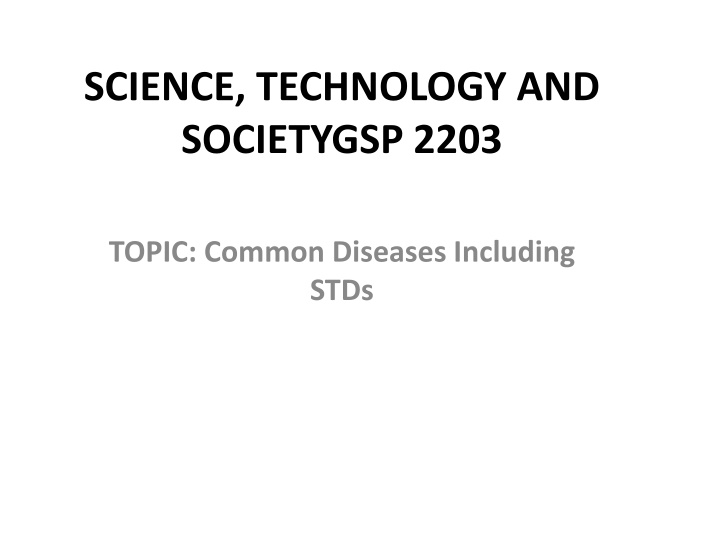
Common Diseases and STDs: A Comprehensive Overview
Explore the complexities of common diseases, including sexually transmitted diseases (STDs), their causes, responses in the body, and management methods. Gain insights into infectious and non-infectious diseases, cancers, and more with Dr. Salisu Ahmed Ibrahim's expertise in human physiology at Bayero University, Kano.
Download Presentation

Please find below an Image/Link to download the presentation.
The content on the website is provided AS IS for your information and personal use only. It may not be sold, licensed, or shared on other websites without obtaining consent from the author. If you encounter any issues during the download, it is possible that the publisher has removed the file from their server.
You are allowed to download the files provided on this website for personal or commercial use, subject to the condition that they are used lawfully. All files are the property of their respective owners.
The content on the website is provided AS IS for your information and personal use only. It may not be sold, licensed, or shared on other websites without obtaining consent from the author.
E N D
Presentation Transcript
SCIENCE, TECHNOLOGY AND SOCIETYGSP 2203 TOPIC: Common Diseases Including STDs
By Dr. Salisu Ahmed Ibrahim Department of Human Physiology Faculty of Basic Medical Sciences, Bayero University, Kano 2019/2020 Session
Synopsis Definition of Disease/illness Types of Diseases Factors that affect Diseases Causation Response of the body to Disease/Coping with Disease Ways of Management of Disease Examples of Infectious Diseases; Examples of Non infectious Diseases; Cancers
LEARNING OBJECTIVES To define a disease process and differentiate the terminologies; disease and illness To know the common types of diseases and STDs To know the factors that affect disease causation To know how the body responds to different types of disease processes
To know some examples of common infectious diseases in this environment To know the examples of non-communicable diseases and cancers To know how common diseases are managed
A disease is an abnormal condition that negatively affects the structure or function of part or all of an organism, and that is not due to any external injury
It is a deviation from the normal structural functional state of an organism associated with certain signs and symptoms differing in nature from physical injury
A disease may be caused by external factors such as pathogens by internal dysfunctions eg immunodeficiency, hypersensitivity, allergies and autoimmune disorders
In humans, disease is often used more broadly to refer to any condition that causes pain, dysfunction, distress, social problems, or death to the person afflicted, or similar problems for those in contact with the person
The terms Illness and sickness are both generally used as a synonym for disease. However, the term illness is occasionally used to refer specifically to the patient's personal experience of his or her disease.
Classifications Of Diseases topographic, by bodily region or system anatomic, by organ or tissue physiological, by function or effect pathological, by the nature of the disease process etiologic (causal) juristic, by speed of advent of death Epidemiological statistical
Factors that affect disease causation epidemiologic triangle -Host such as human being -Agent such as viruses -Environment such as behaviour, affluence, vulnerability, susceptibility etc.
Factors affecting Host resistance to infection Genetic factors Virulency of the organisms concerned Socioeconomic factors Good health care system
Immunity innate immunity acquired immunity
Communicable disease diseases are those transmitted from one organism to another eg Poliomyelitis, HIV, Tuberculosis
Non-communicable diseases cancer, cardiovascular disease (e.g., heart attack, stroke), chronic respiratory disease (e.g., asthma), and diabetes mellitus
Sexually Transmitted Diseases Sexually transmitted diseases (STDs) are infections that pass from one person to another through sexual contact. They are also known as sexually transmitted infections (STIs) or venereal diseases (VD). Some STDs can spread through the use of unsterilized drug needles, from mother to infant during childbirth or breast-feeding, and blood transfusions.
Examples of STDs Syphilis Gonorrhea Chlamydia HIV and AIDS Hepatitis B Virus Caused by Hepatitis Virus infection Trichomoniasis Trichomonas vaginalis Chancroid Haemophilus ducreyi Genital herpes HSV-1 and Human papillomavirus (HPV) Molluscum contagiosum Treponema pallidum Neisseria gonorrhoeae (C. trachomatis) Hiv virus HSV-2 MCV-1, 2,3,4
Management of Diseases treatment with drugs Sanitation proper nutrition adequate exercise Vaccinations public health measures
Prevention of STDs Abstinence Vaccinations Pre-marital screening Avoid alcohol intake Education getting intimate with good person
